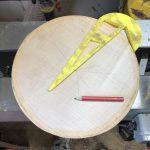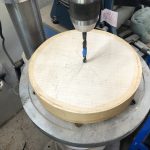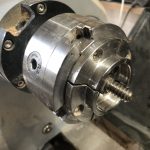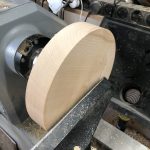Introduction – Starting your first bowl…
Mounting your bowl blank is the first step to getting started. Whether it is square or round, you need to find the centre. There are many tools available to help you be more accurate than just eyeing it up! These include:
- Keith Barrow’s Centre Finder
- Traditional Centre Finder
- Perspex Circle Layout Template
- Traditional compass drawing arcs across the centre with the point on the circumference at quadrant points
The centre is generally first found and marked out on the top of the bowl, which will ultimately be the part hollowed out.
Marking Out the Blank
With a square blank, drawing pencil lines across opposite corners, the intersection marking the centre, is the easiest option. If you’re making a square bowl you’re done, if you’re making a round bowl, remove the blanks corners by bandsaw or hand. If you are finding the centre of a roughly circular blank, centre finders work by enabling you to draw multiple lines from the edges to intersect in the centre. This helps you pinpoint the best centre point. The centre point should be marked with a bradawl or centre punch to form a depression the drill can be started in. Lastly, we have the perspex circle layout template. This is particularly useful when working with uneven natural edge blanks, enabling you to find the optimum centre visually, as the actual centre may not be the best aesthetically for your envisaged design.
Drilling the Pilot Hole
The drill size needs to be equivalent to the core diameter of your worm-screw excluding the thread depth, typically around 8mm. You must only drill the hole deep enough to allow the worm-screw to bite and the blank threaded home to sit snuggly and evenly against all the chuck jaws. Many turners keep a drill just for this process and wrap a piece of electrical tape around the drill to mark the maximum depth. If you have a smaller, shallower blank, you don’t have to use the whole depth of the worm-screw. A spacer can be added made of ply or plastic which sits bewteen the chuck jaws and the blank allowing only three or four threads to penetrate the blank. This perfectly secure for smaller blanks.
The hole needs to be drilled as perpendicular to the blank as possible. I prefer a drill press, but some turners use a battery drill being careful to hold it vertical. The blank can now be threaded onto the worm-screw. The blank should be offered up and screwed on carefully, applying even pressure. The aim is to get the blank screwed fully home touching all the jaws, but not over tightened to the point of possibly stripping the thread in the blank! Spin the blank by hand to check it is running fairly true, don’t worry about slight wobbles, no blank is completely true.
Conclusion
Next, we will look at roughing out the back of your bowl and getting it true.






